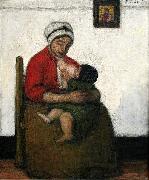Öl auf dem Segeltuch,das echte Aroma von alten Meistern

1
|
|
|||
| Jakob Smits or Jacob Smits (Rotterdam, 9 July 1855 - Achterbos (Mol), 15 February 1928) was a Dutch-Flemish painter. He was born as son of a decorator. Jakob studied in Rotterdam at the academy and helped its father in the decoration business. From 1873 up to 1876 het studied at the Academy in Brussels, and afterwards also in Munich (1878-1880), Vienna (1880) and Rome (1880). In 1882, Jakob married his cousin Antje Doetje Kramer. They settled in Amsterdam, where Smits worked as a painter. He carried out, among other things, tasks for the museum Boijmans-Van Beuningen in Rotterdam. Out of the marriage of Jakob and Antje two children, Theodora and Annie, were born. In 1884, the couple divorced. Jakob Smits moved to Blaricum and in Haarlem becomes director of the Nijverheids- en Decoratieschool (E: Industry and Decoration school). He gets to know Albert Neuhuys, a painter of the The Hague School, and together they make excursions to Drenthe and the Campine in Belgium. Jakob Smits becomes impressed by the Campine landscape and he establishes himself in 1888, definitively in Achterbos (Mol). He pays 2,000 Belgian francs for a small farm which he develops to his Malvinahof. In the same year he marries Malvina Dedeyn, the daughter of a Brussels lawyer, who is disinherited because of this marriage. Smits lives in poverty while he works tirelessly for what he will call my simple work, symbolic, poetic and real. In 1897, he received a gold medal for his exhibitions of large water-colour paintings on a gold background in Munich and Dresden. He also paints a lot of portraits, especially of Malvina and of their children Boby, Marguerite and Kobe. In 1899 destiny strikes: in a few days time he loses his daughter Alice and his wife. In 1901, Smits marries with Josine Van Cauteren. In the same year he holds his first individual exposition in Antwerp. There he obtains much praise of colleagues and critics but finds no buyer for his work. The exhibited work De vader van de veroordeelde (E: the father of the convict) was acquired later that year by the Museum of Brussels. Smits financial situation improved somewhat, but his family was put heavily on the test. In 1903 both his parents were ruined by a robbery and as a resulthe now had nine family members to maintain. At the request of the municipal authorities of Mol, Smits in 1907, arranged an international exhibition of artists who came to paint landscapes in Mol and its surroundings. The artist Paula Van Rompa-Zenke belonged to the arranging committee. There were no less than 68 painters participating, with Germans, Dutch, and Americans coming to Mol. The term Molse School was born. In 1910, Smits published an album with 25 engravings, which was dedicated to Queen Elisabeth. In 1912, the young Dirk Baksteen became a student of Smits. In 1914, Smits stopped with the production of art work. He became President of the Comite voor hulpverlening en voedselvoorziening van het canton Mol (E: Committee for assistance and food supplies of the canton Mol). After World War I he continued his work with a totally new vision and style as engrave and painter. | |||
|
|
|||

| |||
|
|
|||
|
|
|||
1 | Vorheriger Künstler Nächster Künstler | ||






